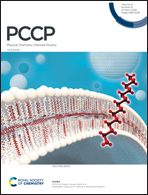Si2C5H2 isomers – search algorithms versus chemical intuition†
Abstract
The pros and cons of using search algorithms alone in identifying new geometries have been discussed by using the Si2C5H2 elemental composition as an example. Within 30 kcal mol−1 at the CCSD(T)/def2-TZVP//PBE0/def2-TZVP level of theory, the coalescence kick and cuckoo methods postulate merely four isomers (1, 3, 6, and 7) for Si2C5H2 (O. Yañez et. al., Chem. Commun., 2017, 53, 12112). On the contrary, chemical intuition yields fourteen (2, 4, 5, and 8–18) new isomers within the same energy range at the B3LYP/6-311++G(2d,2p) level of theory. Based on the relative energies of the first eleven isomers of Si2C5H2 (1, C2v, 0.00; 2, Cs, 21.39; 3, Cs, 21.95; 4, Cs, 22.76; 5, Cs, 24.74; 6, Cs, 25.34; 7, Cs, 25.64; 8, Cs, 25.79; 9, Cs, 27.20; 10, C2v, 28.59; and 11, C2v, 29.16 kcal mol−1) calculated at the CCSD(T)/cc-pVTZ level of theory, it is evident that the search algorithms had missed at least seven isomers in the same energy range. The relative energy gaps of isomers 12–18 fall in the range of 30–40 kcal mol−1 at the latter level of theory. Consequentially, this scenario triggers a speculation going forward with search algorithms alone in the search of all new isomers. While one cannot underestimate the power of these algorithms, the role of chemical intuition may not be completely neglected. Retrospectively, the fourteen new isomers found by chemical intuition may help in writing better search algorithms. All eighteen isomers – including the most stable isomer with a planar tetracoordinate carbon atom 1 – remain elusive in the laboratory to date. Thus, structural and spectroscopic parameters have been presented here, which may possibly aid the future experimental studies.



 Please wait while we load your content...
Please wait while we load your content...